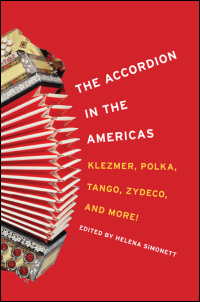A-F
A is for Accordion
 The accordion in the Americas : klezmer, polka, tango, zydeco, and more! / edited by Helena Simonett.
The accordion in the Americas : klezmer, polka, tango, zydeco, and more! / edited by Helena Simonett.
Urbana : University of Illinois Press, c2012
Rita Benton Music Library ML1083 .A23 2012
"This rich collection considers the accordion and its myriad forms, from the concertina, button accordion, and piano accordion familiar in European and North American music to the exotic-sounding South American bandoneón and the sanfoninha. Capturing the instrument's spread and adaptation to many different cultures in North and South America, contributors illuminate how the accordion factored into power struggles over aesthetic values between elites and working-class people who often were members of immigrant and/or marginalized ethnic communities. Specific histories and cultural contexts discussed include the accordion in Brazil, Argentine tango, accordion traditions in Colombia and the Dominican Republic, cross-border accordion culture between Mexico and Texas, Cajun and Creole identity, working-class culture near Lake Superior, the virtuoso Italian-American and Klezmer accordions, Native American dance music, and American avant-garde."
B is for Blues
Bessie / screenplay by Dee Rees and Christopher Cleveland & Bettina Gilois ; directed by Dee Rees.
[United States] : Home Box Office, [2015]
"I wish she was recorded with modern equipment because I think her vocals are so powerful. When you listen to the small inflections, her vibratos, the way she said certain words, like even if it's just saying "here" — or "heeyah" — I mean, I'm still working on how to say it the way she said it, but she had this crazy vibrato that was so different than anyone I had ever heard."- Queen Latifah, speaking of Smith's singing style, interview with NPR, May 16, 2015
C is for Cylinder
 Edison Blue Amberol cylinder canisters (1912-1929)
Edison Blue Amberol cylinder canisters (1912-1929)
Cylinders captured sound in wax impression; a medium that was easily damaged. Blue Amberol added celluloid to the mix, played for around four minutes, and were certainly sturdier...at least in their own time. The material proved to be less stable over time. A wax cylinder would have less chance of surviving a hundred years later, but it would be more likely to hold and playback its audio than a Blue Amberol recording.Listen
If you've never heard a cylinder, check out the Belfer Audio Archive at Syracuse University. They have an online collection of transferred cylinders you can stream for free.
Watch
If you'd like to see how cylinders were created, watch this video from the Edison National Historic Site.
D is for Dance
 Danzas argentinas. Argentine dances. Estampas coloreadas por Aurora de Pietro. Texto y música de Carlos Vega. [Versión inglesa de Sara Diehl de Moreno Hueyo]
Danzas argentinas. Argentine dances. Estampas coloreadas por Aurora de Pietro. Texto y música de Carlos Vega. [Versión inglesa de Sara Diehl de Moreno Hueyo]
Buenos Aires [Carau] 1960-
Rita Benton Music Library FOLIO GV1635 .P52
The dance in this illustration is the Chacarera, a group dance from northern Argentina.
Listen
Check out Smithsonian Folkways' website to hear a chacarera and to learn more about this particular dance.
Watch
E is for Echo
 Phonurgia nova / Athanasius Kircher *
Phonurgia nova / Athanasius Kircher *
Campidonœ, per Rudolphum Dreherr, 1673.
Rita Benton Music Rare Book Room FOLIO ML3805.A2 K58
*The copy included in the exhibit is a facsimile of the original, which is viewable in the Rita Benton Music Library's Rare Book Room.
F is for Fanfare
 Edison Blue Amberol cylinder canisters (1912-1929)
Edison Blue Amberol cylinder canisters (1912-1929)
 Phonurgia nova / Athanasius Kircher *
Phonurgia nova / Athanasius Kircher *
